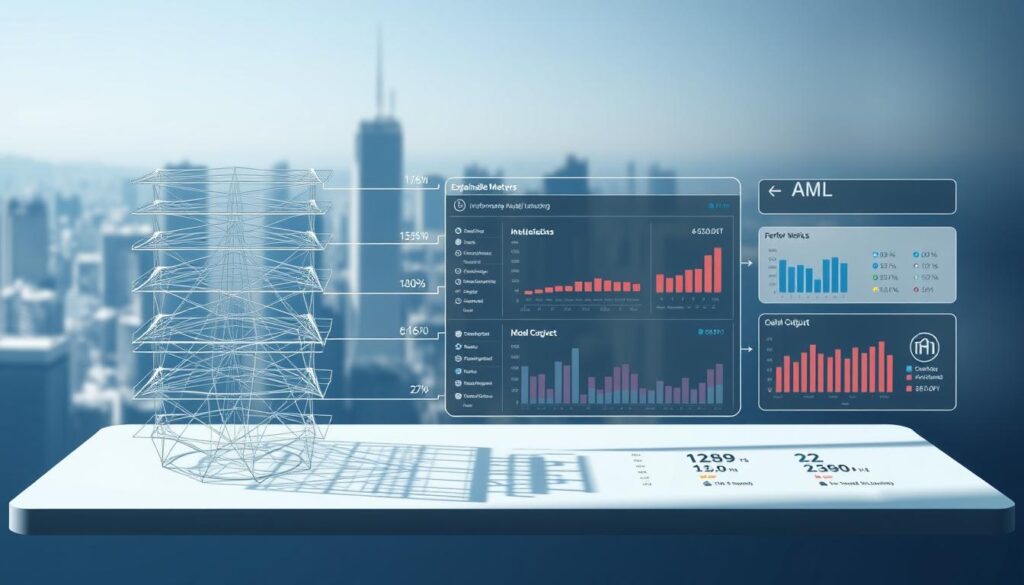Now Reading: Effective Machine Learning Crypto Compliance Monitoring Tools
- 01
Effective Machine Learning Crypto Compliance Monitoring Tools
Effective Machine Learning Crypto Compliance Monitoring Tools

The digital asset industry faces a unique challenge. Global regulations are tightening, demanding greater oversight. Traditional methods often fall short in this fast-paced environment.
Financial institutions and blockchain platforms need smarter systems. These systems must detect suspicious activity accurately. They also need to keep up with evolving threats.
Advanced technology offers a powerful solution. It shifts the approach from reactive to proactive. This allows for the identification of complex patterns that are easy to miss.
This article explores how intelligent systems protect businesses. They help avoid regulatory penalties and reduce operational friction. Adopting these tools is becoming essential for success.
We will cover the regulatory landscape and practical implementation strategies. The goal is a balance of accuracy, transparency, and cost-effectiveness. Discover how AI and machine learning are transforming AML for the better.
Key Takeaways
- Regulatory scrutiny is increasing globally for the digital currency sector.
- Traditional oversight methods struggle with the decentralized nature of digital assets.
- Intelligent systems are necessary for proactive detection of suspicious activities.
- Advanced technology helps reduce false positives and operational burdens.
- Adopting modern tools is crucial for maintaining regulatory adherence and protecting an organization.
- A balanced approach focuses on accuracy, transparency, and managing costs effectively.
Understanding the Crypto Compliance Landscape
Global financial authorities have established complex oversight requirements for virtual asset operations. This creates a challenging environment for organizations navigating international boundaries.
Regulatory Challenges and Evolving Requirements
Different jurisdictions impose varying rules for digital currency activities. The FATF, SEC, and EU authorities each set distinct standards. Organizations must adapt to frequent updates in anti-money laundering guidelines.
| Regulatory Body | Key Focus Areas | Jurisdictional Scope |
|---|---|---|
| Financial Action Task Force (FATF) | Virtual assets, beneficial ownership | Global recommendations |
| U.S. Securities and Exchange Commission (SEC) | Securities regulations, investor protection | United States markets |
| European Union Authorities | AML/CFT directives, cross-border operations | EU member states |
The Importance of Transparency in Crypto Transactions
Visibility into transaction flows is essential for regulatory adherence. The pseudonymous nature of blockchain activities requires sophisticated tracking systems. Proper blockchain analysis helps identify ultimate beneficial owners and suspicious patterns.
What is Machine Learning Crypto Compliance Monitoring?
The evolution from manual oversight to automated detection represents a fundamental shift in financial security protocols. This advanced approach uses artificial intelligence to analyze digital currency activities more effectively than traditional methods.
Core Concepts and Benefits
Modern systems learn from historical examples of both legitimate and suspicious activities. They continuously improve their detection capabilities as they process more information. This represents a significant advancement over static rule-based methods.
Traditional approaches rely on manually coded business rules that can only identify known patterns. In contrast, algorithmic systems can discover previously unknown suspicious behaviors directly from the data itself. This adaptive capability is crucial in today’s rapidly changing financial landscape.
| Feature | Traditional Rules-Based | Modern Algorithmic Approach |
|---|---|---|
| Pattern Detection | Only known fraud patterns | Unknown and evolving patterns |
| Update Process | Manual, costly updates | Continuous, automated learning |
| False Positive Rate | Typically higher | Significantly reduced |
| Scalability | Limited by manual capacity | Handles vast data volumes |

The primary benefits include reduced risk exposure by catching sophisticated schemes and lower operational costs through automation. These systems also minimize customer friction by dramatically reducing false positives that block legitimate transactions.
This technology represents a fundamental shift in how organizations approach financial security. It moves from reactive rule-checking to proactive pattern recognition and anomaly detection.
Leveraging AI for Enhanced AML Compliance
Artificial intelligence brings unprecedented capabilities to anti-money laundering efforts. These systems automate critical processes that traditionally required extensive manual work. The technology handles customer verification, ongoing oversight, and comprehensive evaluation simultaneously.

Enhanced Due Diligence and Risk Assessment
Intelligent systems perform thorough background checks during customer onboarding. They cross-reference information against multiple databases including government records and sanctions lists. This verification happens quickly while maintaining accuracy.
The technology analyzes customer profiles to identify potential risks. It detects unusual patterns that might indicate fraudulent intentions. This proactive approach prevents problematic accounts from being created.
Real-Time Transaction Monitoring Insights
Advanced systems watch financial activities as they occur on blockchain networks. They flag operations that deviate from normal behavioral patterns. Immediate alerts allow for quick response to potential threats.
These tools recognize complex schemes involving multiple accounts or jurisdictions. They identify subtle patterns that human reviewers might miss. The result is improved detection of sophisticated illicit activities.
Automation reduces the workload for human teams. Staff can focus on investigating genuine alerts rather than sorting through false positives. This creates a more efficient and effective security environment.
Building a Robust Machine Learning System for Compliance
The quality of input information directly determines the effectiveness of automated security solutions. Poor data contributes to false AML alerts costing organizations millions annually. Proper foundation building ensures your detection platform performs optimally from day one.
Data Integration and Model Training
Successful systems aggregate information from multiple sources. This includes blockchain networks, customer profiles, and external risk intelligence. Unified formatting prepares this diverse information for analysis.

Context-driven enrichment significantly improves detection capabilities. Adding industry risks and customer behavior history to basic transaction data creates richer profiles. This approach reduces false positives while maintaining strong security.
Training algorithms requires carefully labeled examples of both legitimate and suspicious activities. Financial institutions face the challenge of balancing labeling costs with effectiveness. Semi-supervised approaches can help manage expenses while maintaining accuracy.
Ensuring Accuracy and Anomaly Detection
These systems excel at identifying unusual patterns in vast datasets. They detect subtle anomalies that traditional methods often miss. This makes them ideal for combating sophisticated financial crimes.
Validation techniques ensure model reliability before deployment. Backtesting against historical information and cross-validation methods measure performance. Key metrics like precision and recall balance threat detection with false alarm reduction.
Building an effective system requires ongoing refinement rather than one-time setup. Continuous monitoring and periodic retraining adapt to evolving money laundering techniques. This creates a dynamic defense that grows smarter over time.
Integrating Explainable AI for Transparency
A critical hurdle emerges when advanced detection systems flag suspicious activity without providing clear reasoning. Compliance teams need understandable explanations for every alert they investigate. This requirement makes transparency essential for regulatory acceptance.

Explainable AI (XAI) solves this challenge by making algorithmic decisions understandable to humans. It transforms complex scoring into actionable insights that compliance officers can trust. This approach builds confidence in automated oversight.
Overcoming Black Box Limitations
Traditional algorithmic models often function as black boxes. They identify patterns effectively but offer no justification for their conclusions. XAI introduces three core principles to address this limitation:
- Interpretability: Understanding how the model reached each decision
- Accountability: Providing auditable justifications for regulatory review
- Transparency: Revealing the internal logic behind risk assessments
Specific techniques like LIME provide human-readable reasons for individual alerts. It might highlight “transaction to high-risk jurisdiction” or “unusual amount” as contributing factors. SHAP methodology reveals multiple evidence points including customer connections and behavioral patterns.
Simpler feature importance techniques act as report cards for risk assessment. They show which data points influenced decisions most significantly. This helps investigators prioritize their review efforts effectively.
These strategies ensure regulatory requirements for accountability are met. They transform advanced detection from an opaque process into a transparent partnership between technology and human expertise.
Cost-Effective Strategies in AML Monitoring
Financial institutions face significant economic pressure from inefficient anti-money laundering oversight. Traditional approaches create substantial operational burdens while missing sophisticated threats. Modern solutions offer a path to both better security and reduced expenses.
Conventional rule-based systems generate alarm rates exceeding 95% false positives. This means compliance teams spend most of their time investigating legitimate activities. The financial impact reaches $12.9 million annually for many organizations.
Optimizing Resource Allocation and Reducing False Positives
Advanced detection technology dramatically improves resource allocation. These systems learn to distinguish between genuine threats and harmless patterns. This allows your team to focus on actual risks rather than false alarms.
Human-in-the-loop techniques make the training process more efficient. Experts review only the most uncertain cases rather than labeling everything manually. This approach maintains high accuracy while reducing labeling costs significantly.
| Cost Factor | Traditional Approach | Modern Approach |
|---|---|---|
| False Positive Investigation | High (95%+ of alerts) | Low (under 10% of alerts) |
| Staffing Requirements | Large teams needed | Small, focused teams |
| Regulatory Penalty Risk | Higher due to missed threats | Lower through better detection |
| Customer Friction Costs | Revenue loss from blocked transactions | Smooth customer experience |
Automation reduces the need for large compliance departments. Staff can shift from repetitive reviews to strategic risk assessment. This creates meaningful cost savings while improving oversight quality.
Calculating ROI involves multiple factors. Consider reduced investigation time, avoided penalties, and improved customer retention. The initial technology investment typically pays for itself within the first year.
Practical Implementation Guide for Compliance Tools
Implementing advanced detection tools requires careful planning and a structured approach. Organizations must balance technological capabilities with regulatory requirements while ensuring smooth integration into existing workflows.
Step-by-Step Process for Deployment
Begin by aligning stakeholders across legal, technology, and business teams. This ensures the implementation serves organizational needs while meeting regulatory expectations. Clear communication establishes shared goals from the start.
Select appropriate platforms based on detection accuracy and integration capabilities. Evaluate vendors for explainability features and regulatory coverage. Consider total cost of ownership alongside technical requirements.
Implement AI-powered KYC processes that automatically verify customer information during account creation. These systems check identification documents against sanctions lists efficiently. They maintain thorough due diligence while streamlining onboarding.
Integrate real-time transaction monitoring that analyzes blockchain activity continuously. The system flags suspicious transactions based on learned patterns. Contextual understanding helps minimize false positives effectively.
Establish automated suspicious activity report generation with detailed evidence documentation. Create draft reports that comply with regulatory requirements for human review. This combination maintains accuracy while reducing manual workload.
Configure comprehensive audit trails logging all customer interactions and risk assessments. This transparent documentation satisfies regulator expectations. It also supports continuous process improvement over time.
Train teams to work effectively with new tools while maintaining human oversight of critical decisions. Phased rollout strategies allow for performance measurement and refinement. Start with pilot programs before expanding to full production deployment.
Conclusion
Forward-thinking organizations are embracing next-generation solutions to navigate complex regulatory demands. This represents a fundamental transformation in financial security approaches.
Intelligent systems deliver enhanced due diligence and real-time oversight capabilities. They identify sophisticated patterns while reducing operational burdens significantly.
The importance of transparent decision-making cannot be overstated. Explainable AI builds trust with regulators and ensures accountability throughout the risk assessment process.
Successful implementation balances technological power with human expertise. This partnership creates a robust defense against evolving threats in the digital finance industry.
Adopting these tools positions organizations for long-term success. They gain competitive advantage through improved accuracy, customer experience, and regulatory adherence.
FAQ
How does artificial intelligence improve anti-money laundering efforts?
AI enhances AML programs by analyzing vast amounts of transaction data to identify complex patterns and suspicious activity. It automates risk assessment and due diligence, allowing teams to focus on high-risk alerts. This approach increases detection accuracy and operational efficiency for organizations.
What role does transparency play in financial monitoring systems?
Transparency is critical for building trust with regulators and customers. Explainable AI platforms help clarify why certain transactions are flagged, moving beyond traditional black box limitations. This clarity supports better decision-making and smoother audits for business operations.
Why is real-time monitoring important for detecting money laundering threats?
Real-time systems provide immediate insights into transaction data, enabling swift action against potential fraud and laundering attempts. This proactive approach helps mitigate risks before they escalate, protecting the business and maintaining regulatory compliance.
How can companies reduce false positives in their transaction monitoring processes?
Advanced analytics and machine learning models learn from historical data to better distinguish between normal and anomalous patterns. This continuous learning process refines alert accuracy, significantly lowering false positives and optimizing resource allocation for compliance teams.
What are the key steps for deploying a new AML monitoring platform?
Successful deployment involves careful data integration, model training with relevant financial information, and thorough testing. A step-by-step implementation guide ensures the system aligns with existing regulations and business processes, minimizing disruption while maximizing effectiveness.











